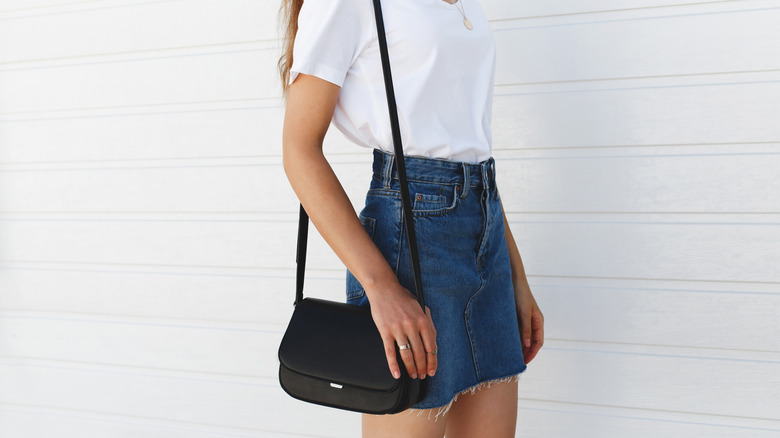What Is 'Recession Core,' And Why Are You Seeing It Everywhere Right Now?
Times of economic prosperity and economic downturn have always affected fashion. Take the 1920's for instance; after WWI and before the Great Depression, there was a period of affluence known as the roaring twenties, when gilded age parties like those depicted in "The Great Gatsby" were the rage and people dressed in flashy, newly-vampy style. The dresses were shorter and the makeup was bolder. After the great stock market crash of 1929, however, popular fashion took a hard turn toward simpler, more frugal, more practical style.
The same thing happened after the start of the Great Recession in 2008 (via Her Campus). The intentionally-flashy, gaudy, shiny, colorful, eclectic styles of the early oughts were pretty quickly replaced by styles that featured more simple, classic, timeless cuts, lines, and colors. Even though these simpler styles didn't necessarily cost less than their louder counterparts, they were seen as more appropriate for the mood of the time, which was one of national and international penny-pinching and financial panic.
Today, in a post-Covid world, with home prices far out of reach for many Americans and inflation making everything from a carton of eggs to a bag of frozen peas significantly more expensive than they were not very long ago, we are once again seeing the fashion world tilt toward what is being called "recession chic" or "recession core."
The Hemline Index and the modern world
The Hemline Index was first introduced at Wharton Business school in 1926 by a professor named George Taylor (via Express). The theory, essentially, was that skirts became shorter in better economic times because women could afford proper hosiery to pair with those shorter skirts. Hemlines got longer again in poor economic times so that women who could not afford hosiery could still wear their everyday clothes while appearing "proper." However, as more modern science has proven, it wasn't so much the actual prices of things that changed fashion trends like skirt lengths; it was psychological factors that go along with times of economic prosperity and economic crisis.
In other words, it wasn't necessarily that people could afford flashier fashion in good times and couldn't in bad times; it was that people generally felt certain things were and were not appropriate in times of hardship versus times of celebration. Currently, we are seeing symptoms of the same psychological ideas about fashion play out right in front of our eyes. There is a trend to simplify everything from skincare routines to makeup routines to clothing staples, whereas just a few years ago, influencer culture was all the rage, and everything from full faces of makeup to complex, multi-step skincare routines were practically expected.
Now, however, there is a push for simplicity in all forms of fashion, from the clothes we buy to how we wear them, from the makeup we wear to how we use it.
De-influencing and simplicity reign supreme
The current trend of "de-influencing" along with the reappearance of simple wardrobe staples like the maxi denim skirt and other 90's-inspired looks full of muted colors and versatile separates can be attributed to the inevitable resurgence of recession core style (via Her Campus). And it makes sense. When grocery bills are at an all-time high, many people simply can't afford to replenish a multi-step skincare routine and a cosmetics bag full of countless colors and products. And because many of us can't afford it, it becomes unseemly for even those who can afford it (like models representing major fashion brands) to step out in outlandish style.
Instead, even the wealthiest among us and the companies who help to guide and create fashion trends see this economic downturn coming, and are trying to remain relevant and while not to turn off their fanbase by appearing cognizant of the common person's struggles, even if their clothing, makeup, skincare, etc. hasn't actually gotten more affordable or dropped in price.
Essentially, it's all about appealing to our innate instincts to lean toward all things practical and frugal during a recession.


